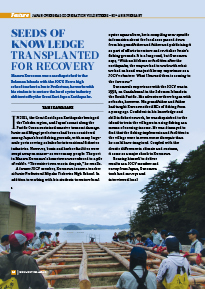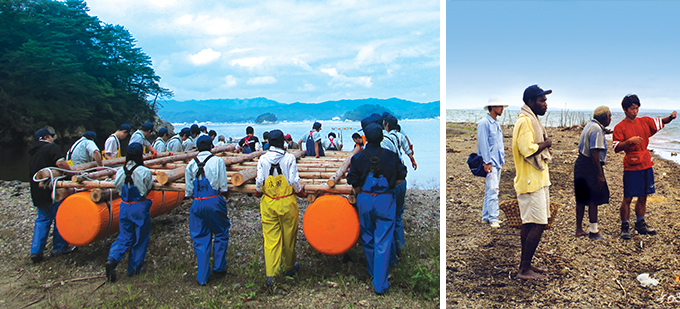Home > Highlighting JAPAN >Highlighting Japan August 2015>Japan Overseas Cooperation Volunteers—50th Anniversary
Highlighting JAPAN

Japan Overseas Cooperation Volunteers—50th Anniversary
Seeds of Knowledge Transplanted for Recovery
Masaru Kurosawa was once dispatched to the Solomon Islands with the JOCV. Now a high school teacher in Iwate Prefecture, he works with his students to restore the local oyster industry obliterated by the Great East Japan Earthquake.

In 2011, the Great East Japan Earthquake besieged the Tohoku region, and Japan’s coast along the Pacific Ocean sustained massive tsunami damage. Iwate and Miyagi prefectures had been considered among Japan’s best fishing grounds, with many large-scale ports serving as hubs for international fisheries industries. However, boats and harbor facilities were swept away en masse—as were many people. The port in Masaru Kurosawa’s hometown was reduced to a pile of rubble. “The entire town was in despair,” he recalls.
A former JOCV member, Kurosawa is now a teacher at Iwate Prefectural Miyako Fisheries High School. In addition to working with his students to restore local oyster aquaculture, he is compiling area-specific information about the local seas passed down from his grandfather and father and publicizing it as part of efforts to restore and revitalize Iwate’s fishing grounds. It is a long road, but Kurosawa says, “With no lifelines or facilities after the earthquake, the way we had to work with what we had on hand was just like my experience as a JOCV volunteer. What I learned then is coming to the fore now.”
Kurosawa’s experience with the JOCV was in 1998, on Guadalcanal in the Solomon Islands in the South Pacific. His adventure there began with setbacks, however. His grandfather and father had taught Kurosawa the ABCs of fishing from a young age. Confident in his knowledge and skill in fisheries work, he was dispatched to the island to train the villagers in using fishing as a means of earning income. He was dismayed to find that the fishing implements and facilities in the village were in even worse disrepair than he could have imagined. Coupled with the drastic difference in climate and customs, it came as a major shock to Kurosawa.
Rousing himself to deliver results as a JOCV member and envoy from Japan, Kurosawa took land surveys and interviewed local fishermen. Understanding the local waters in theory, however, was not the same as braving them in person. The waves would shake the boat and the fishing gear would fall overboard.
“I would make dumb mistakes like that and the local fishermen would laugh at me,” he remembers. “Until that time, I was confident of my abilities, so the feeling of self-loathing kept me awake at nights.” After much trial and error, he discovered a way of catching so many fish that it surprised not only the locals but also Kurosawa himself.
In between these labors, Kurosawa taught the local children soccer and karate, and they in turn taught him the local language. Soon enough, he was treated as one of the villagers and was invited to village rites and festivals. An ethnic conflict broke out a year later, however, and Kurosawa moved on to his next location, feeling pangs of regret at being unable to help. The struggles he faced in Guadalcanal became a precious memory for him, and he considered going abroad again.
Amid these life twists and turns, Kurosawa arrived at his current position as a teacher, but he still had some doubts. He did not feel up to the task of engrossing himself in education and changing children’s lives. However, he says the 2011 earthquake changed him. The town was in a state of hopelessness, yet the seasons kept coming, and seaweed started to grow in the ruins of the harbor, with fish coming in. “The children, too, would grow up,” he says. “I realized I had to do my part to revitalize the fisheries for the sake of students at the Fisheries High School.”
After considering what he could do, Kurosawa set his sights on oyster culturing and the cultivation of seed oysters to drive this effort. Because of the earthquake, seed oysters were difficult to come by in neighboring Miyagi Prefecture, paralyzing Iwate’s own oyster industry. It has been sixty years since the last seed oyster was caught in Iwate, for reasons unknown. The condition is so pronounced that it is said the discovery of seed oysters would revolutionize Iwate’s fisheries. This is why Kurosawa feels such a sense of purpose, and he has his work cut out for him. He and the students continue to chop wood, building platforms for the spawning grounds and continuing to research how to develop the next seed oyster.
“The disaster has given us an opportunity to rise to the challenge for Iwate’s salvation,” says Kurosawa. “I hope the students here do not forget the spirit of contributing to the local region even after they graduate and become adults.” The influence of his grandfather and father, who taught Kurosawa about the grandeur of the ocean, looms large, and his experiences with the JOCV and the earthquake are giving him the unstinting resolve to be a local educator tied closely to the region.
© 2009 Cabinet Office, Government of Japan






